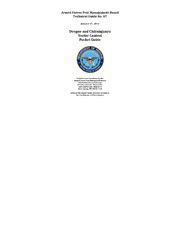Table Of ContentArmed Forces Pest Management Board
Technical Guide No. 47
January 27, 2012
Dengue and Chikungunya
Vector Control
Pocket Guide
Published and Distributed by the
Armed Forces Pest Management Board
Information Services Division
US Army Garrison―Forest Glen
2460 Linden Lane, Bldg #172
Silver Spring, MD 20910‐1230
Office of the Deputy Under Secretary of Defense
For Installations and Environment
Report Documentation Page Form Approved
OMB No. 0704-0188
Public reporting burden for the collection of information is estimated to average 1 hour per response, including the time for reviewing instructions, searching existing data sources, gathering and
maintaining the data needed, and completing and reviewing the collection of information. Send comments regarding this burden estimate or any other aspect of this collection of information,
including suggestions for reducing this burden, to Washington Headquarters Services, Directorate for Information Operations and Reports, 1215 Jefferson Davis Highway, Suite 1204, Arlington
VA 22202-4302. Respondents should be aware that notwithstanding any other provision of law, no person shall be subject to a penalty for failing to comply with a collection of information if it
does not display a currently valid OMB control number.
1. REPORT DATE 3. DATES COVERED
27 JAN 2012 2. REPORT TYPE 00-00-2012 to 00-00-2012
4. TITLE AND SUBTITLE 5a. CONTRACT NUMBER
Dengue and Chikungunya Vector Control Pocket Guide
5b. GRANT NUMBER
5c. PROGRAM ELEMENT NUMBER
6. AUTHOR(S) 5d. PROJECT NUMBER
5e. TASK NUMBER
5f. WORK UNIT NUMBER
7. PERFORMING ORGANIZATION NAME(S) AND ADDRESS(ES) 8. PERFORMING ORGANIZATION
Armed Forces Pest Management Board,Information Services Division, REPORT NUMBER
US Army Garrison―Forest Glen,2460 Linden Lane, Bldg
#172,Silver Spring,MD,20910
9. SPONSORING/MONITORING AGENCY NAME(S) AND ADDRESS(ES) 10. SPONSOR/MONITOR’S ACRONYM(S)
11. SPONSOR/MONITOR’S REPORT
NUMBER(S)
12. DISTRIBUTION/AVAILABILITY STATEMENT
Approved for public release; distribution unlimited
13. SUPPLEMENTARY NOTES
14. ABSTRACT
15. SUBJECT TERMS
16. SECURITY CLASSIFICATION OF: 17. LIMITATION OF 18. NUMBER 19a. NAME OF
ABSTRACT OF PAGES RESPONSIBLE PERSON
a. REPORT b. ABSTRACT c. THIS PAGE Same as 35
unclassified unclassified unclassified Report (SAR)
Standard Form 298 (Rev. 8-98)
Prescribed by ANSI Std Z39-18
Acknowledgements
This Armed Forces Pest Management Board (AFPMB)
Technical Guide (TG) was written by LCDR Craig Stoops and
LT Anthony Hanley of the U.S. Navy Entomology Center of
Excellence, Dr. Gary Clark, USDA‐ARS Center for Medical,
Agricultural and Veterinary Entomology, and Dr. Graham
White, AFPMB.
Disclaimer
Any mention of specific proprietary products, trade names,
or manufacturers does not constitute a recommendation or
an official endorsement of these products by the Department
of Defense but is intended for illustration and information
purposes only. Neither should the absence of an item
necessarily be interpreted as DoD disapproval. Information
or inquiries concerning any equipment or items should be
sent through Command Pest Management Professionals or
Applied Biologists to the Armed Forces Pest Management
Board Medical Entomology Committee for evaluation.
-1-
Foreword
This technical guide (TG) was written to consolidate
information and procedures for surveillance and
control of mosquitoes that transmit dengue and
chikungunya viruses. This TG focuses on mosquitoes
that transmit dengue but also makes reference to
chikungunya and yellow fever because the pathogens
that cause these diseases may be transmitted by the
same mosquito species. Thus, control of dengue
vectors will also control the spread of these diseases.
This TG is not a regulation but provides guidance to
those individuals responsible for conducting pest
control and surveillance during military deployments.
This TG will receive periodic review and will be
updated to ensure that information presented reflects
current technology and guidance. Individuals using
this TG are encouraged to submit comments and
suggestions for improvement to the Director, Armed
Forces Pest Management Board, US Army
Garrison―Forest Glen, 2460 Linden Lane, Bldg #172,
Silver Spring, MD 20910‐1230: (301) 295‐7476; Fax
(301) 295‐7473.
-2-
Table of Contents
1. Introduction.………………………………………….4
2. Identification/Biology.………...…………………7
3. Surveillance…………….....…..…………………….10
4. Control…………………………………………………20
5. Personal Protection………………………………29
6. Additional Guidance..……………………………..31
7. References ……………………………………………32
8. Points of Contact……………………………………33
-3-
1. Introduction
This guide is designed to serve as a quick
reference for the identification, surveillance, and
control of mosquito species that transmit
dengue and chikungunya viruses. The three
main components of the guide are
biology/identification, surveillance, and control.
These components are necessary in the
planning, conduct and evaluation of a dengue
vector control program.
This guide is not a comprehensive treatment of
the subject. Please see the Additional Guidance,
References, and Points of Contact sections for in‐
depth information on specific subjects
introduced in this guide.
-4-
Dengue is considered a significant risk to
deployed troops by the National Center for
Medical Intelligence. The approximate
worldwide distribution of dengue viruses is
shown below.
Estimated worldwide dengue distribution. Dengue range
minimum 10oC isotherm, north and south of the tropics.
Orange‐shaded countries are areas where dengue risk is well
known.
Aedes aegypti, Ae. albopictus and Ae. polynesiensis
are three mosquito species that are vectors of
dengue. Aedes aegypti accounts for >95% of all
cases worldwide. During deployments, all three
species must be considered important vectors,
and control measures must be put into place to
protect troop health.
-5-
Chikungunya is another arboviral disease
transmitted to humans by the bite of infective
mosquitoes. Chikungunya virus has caused
human epidemics in many areas of Africa and
Asia, and most recently in a limited area of
Europe (CDC 2008). Both Ae. aegypti and Ae.
albopictus are vectors of chikungunya, and this
virus is of special concern due to the recent
resurgence and spread of these mosquito
species.
Estimated distribution of chikungunya virus.
-6-
2. Identification/Biology
Aedes aegypti
‐ Small black and white mosquito with
markings that look like a guitar on the thorax.
‐ Daytime biter.
‐ Vector of dengue and chikungunya viruses.
CDC map showing dengue outbreaks in red (for year
2000) and wider distribution of the vector Aedes
aegypti in yellow. Distribution: pantropical, Old and
New World tropics, Pacific islands.
-7-
Aedes albopictus
‐ Small black and white mosquito with single white
stripe on thorax.
‐ Daytime biter.
‐ Vector of dengue and chikungunya viruses.
Global distribution of Aedes albopictus:
pantropical, Old and New World tropics, Pacific
islands.
-8-

